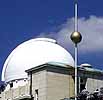| . |  |
. |
 Washington - August 24, 1999 - The U.S. Naval Observatory recently hoisted a time ball into place on the roof of its main building. This time ball will be the official marker of the beginning of the year 2000 and the beginning of the Third Millennium in 2001.
Washington - August 24, 1999 - The U.S. Naval Observatory recently hoisted a time ball into place on the roof of its main building. This time ball will be the official marker of the beginning of the year 2000 and the beginning of the Third Millennium in 2001.By order of then-Secretary of the Navy John Y. Mason, the Naval Observatory dropped the first time ball in the United States in 1845. This was the primary means for disseminating time to the city of Washington and for ships on the Potomac to set their chronometers for navigation. The ball was dropped every day at noon from the Observatory's Foggy Bottom site until 1885, when it was moved to the State, War and Navy Building (now the old Executive Office Building) next to the White House. It was last dropped there in 1936. The dropping of the time ball to usher in the year 2000, by order of the current Secretary of the Navy the Honorable Mr. Richard Danzig, will therefore commemorate an old tradition for Washington and the U.S. Navy. It will, however, be dropped at midnight EST on New Year's Eve rather than noon. The event will be the local culmination of a "round-the-world time ball drop", in which time balls will mark the beginning of the New Year as it sweeps westward from the International Date Line across New Zealand, Australia, India, South Africa, the United Kingdom, and the United States. In addition, USNO is coordinating the local observance of the New Year with U.S. Navy installations and ships around the globe. The Observatory is also a partner in the White House Millennium Program. Time balls were used in many cities around the country and around the world during the 19th century. Those in the U.S. were sometimes dropped by a signal from Washington. Beginning in September, 1877 a time ball atop the Western Union Building in New York City was dropped by telegraphic signal from the Naval Observatory. In the era before time zones, the signal for New York was issued 12 minutes before that for Washington to take into account the longitude difference. At the turn of the 20th century dozens of time balls were being dropped around the world. A few are still ceremonially dropped, ranging from New Zealand to the Old Royal Observatory, Greenwich. The Naval Observatory began as the Depot of Charts and Instruments for the Navy in 1830, maintaining and calibrating sextants and chronometers. From 1844 to 1893 it was located in Foggy Bottom, at the site of the current Navy Bureau of Medicine and Surgery (BUMED). Since 1893, the Naval Observatory has been located at 34th and Massachusetts Avenue, about 2 miles from the Foggy Bottom site and the center of Washington, D.C. Determination and dissemination of time have been an essential part of the Naval Observatory mission since its beginning. During that time clock technology has evolved from precision pendulum clocks to quartz crystal clocks to the present hydrogen maser and cesium-beam atomic clocks. Similarly, time dissemination has evolved from the visual signal represented by the time ball, to the telegraph beginning in the 1860s, to radio signals and finally the Global Positioning System (GPS), for which USNO supplies the time. Clock accuracy has advanced from one-thousandth of a second with the most elaborate pendulum clocks at the beginning of the century, to one billionth of a second per day with the present atomic clocks. Time dissemination, accurate to a few tenths of a second with the time ball, is now accurate to within a few billionths of a second with GPS. Aside from maintaining the Master Clock of the United States, the Observatory produces star catalogs, astronomical and navigational almanacs, and conducts forefront astronomical research. It is building a "cesium fountain" atomic clock to improve time accuracy ten-fold. It has constructed the Navy Prototype Optical Interferometer, which will help improve the celestial reference system and may discover Earth-size planets. The Observatory accurately measures the rotation of the Earth using radio telescopes around the world. And it continues a variety of efforts to improve navigation by land, sea, air and space.
|
| |||||||||
| The content herein, unless otherwise known to be public domain, are Copyright 1995-2016 - Space Media Network. All websites are published in Australia and are solely subject to Australian law and governed by Fair Use principals for news reporting and research purposes. AFP, UPI and IANS news wire stories are copyright Agence France-Presse, United Press International and Indo-Asia News Service. ESA news reports are copyright European Space Agency. All NASA sourced material is public domain. Additional copyrights may apply in whole or part to other bona fide parties. Advertising does not imply endorsement, agreement or approval of any opinions, statements or information provided by Space Media Network on any Web page published or hosted by Space Media Network. Privacy Statement All images and articles appearing on Space Media Network have been edited or digitally altered in some way. Any requests to remove copyright material will be acted upon in a timely and appropriate manner. Any attempt to extort money from Space Media Network will be ignored and reported to Australian Law Enforcement Agencies as a potential case of financial fraud involving the use of a telephonic carriage device or postal service. |